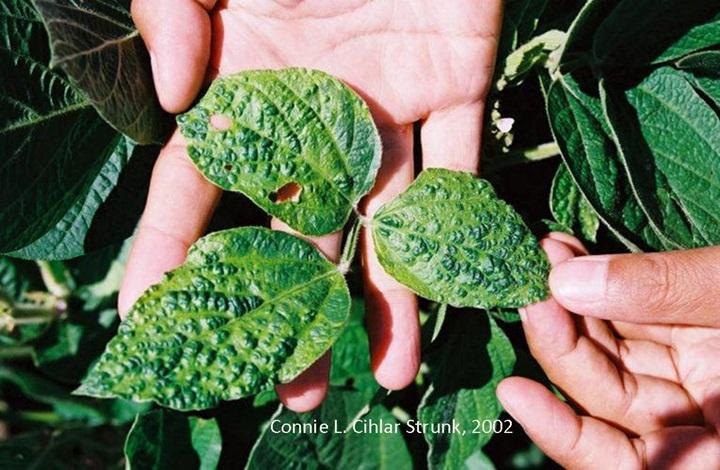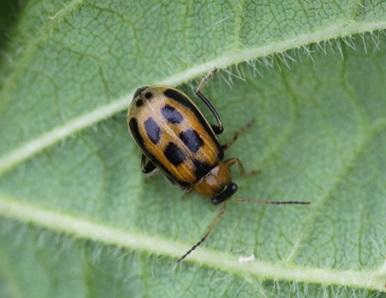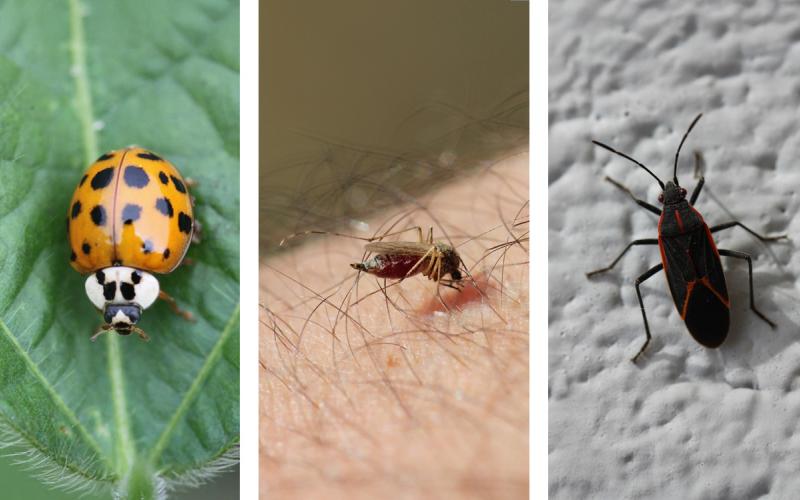With the number of bean leaf beetle observations in soybean fields during 2016, the need for monitoring soybean for Bean pod mottle virus (BPMV) development increases. Bean pod mottle virus was first identified in South Dakota in 1998, and is recognized as a very economically important disease in soybean due to the potential for it to cause devastating losses to soybean yields. In the Southern states, yield losses due to BPMV range between 3 and 52% in late maturity soybean varieties. Research in South Dakota determined that soybean yield losses ranged from 0.9-19.4% in 2002 and 16.8-56.6% in 2003. Other observations from this research were that soybean infected by BPMV had significantly fewer soybean pods per plant compared to uninfected soybean. The average loss ranged from 2-5 pods for the center five nodes, or expressed as percent loss, the reduction in pods ranged from 9.3-27.5 % per plant. The highest loss represents approximately one pod missing from every node.
What does BPMV look like?

Bean pod mottle virus symptoms are commonly confused with herbicide injury and can resemble symptoms of other viruses. Symptoms associated with BPMV include mild to severe chlorotic mottling or mosaic and rugosity (distortion or wrinkling) on foliage and pods, stunting, and delayed maturity (Figure 1). Symptom severity may lessen during hot weather or with maturity; however, the plant still remains infected with the virus. One effect of delayed maturity is green stem where the stem remains green after the soybean pods have matured. Infection by BPMV decreases pod formation and reduces seed size, weight, and number. Seed coat mottling (the discoloration of the seed due to a black or brown pigmentation bleeding from the hilum) is another symptom caused by BPMV infection. Mottled soybean seeds are signs of poor seed quality, resulting in financial penalties when soybean are docked at the time of sale. Bean pod mottle virus is also associated with increases in seed infection by Phomopsis spp.
How is BPMV spread?
Bean pod mottle virus is primarily vectored by the bean leaf beetle, Cerotoma trifurcata (Forster) in the United States. When bean leaf beetles feed on BPMV-infected soybean plants they also ingest the virus and become a carrier (viruliferous). The virus can be obtained with a single bite of an infected plant. Virus transmission occurs rapidly with the next feeding. As the beetle moves throughout the field, it spreads the virus to new locations. Not only is the beetle an efficient vector, but it also feeds on the soybean foliage resulting in defoliation. Later in the season the bean leaf beetles will feed not only on the leaves but also on soybean pods and are capable of causing yield loss by clipping the pods from the plant prior to harvest.
How do I identify the Bean Leaf Beetle?

As mentioned in the previous article Bean Leaf Beetle Emergence and Soybean Defoliation Underway, bean leaf beetles are approximately 3/16 of an inch long and can vary in color and spotting pattern. However, they can be identified by the black triangle located behind the thorax on the elytra (Figure 2). In South Dakota, there is an overwintering population of bean leaf beetles, that have an emergence period that occurs as soybean emerge. Depending on the location within the state there may be one (Northern SD) or two additional generations (Southern SD). These additional generations will be present later in the season, and will feed on both foliage and pods.
Disease Management
Currently, the most practiced and promising management techniques involve using insecticide applications to manage bean leaf beetle populations, which inhibits the spread of BPMV. There is no chemical control available for BPMV infected plants found in the field. To date, no soybean cultivars have been found to be resistant to BPMV.


